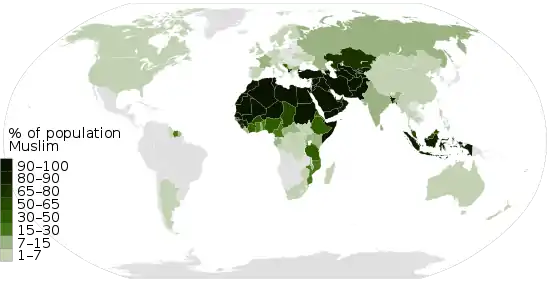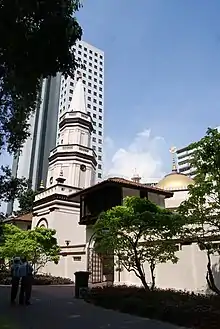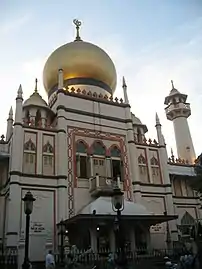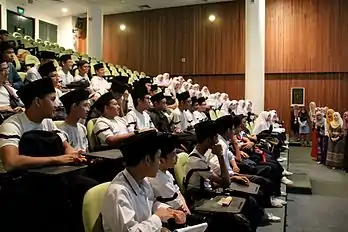Islam in Singapore
In Singapore, Islam is a minority religion. According to the country's most recent census in 2015, the religion makes up 14% of its resident population.[1] A majority of Malays are Sunni Muslims.[2] Other smaller adherents include those from the Arab, Chinese, Eurasian and Indian communities.[3]
| Islam by country |
|---|
 |
|
|

Singaporeans who are Muslims are Sunni and mostly belong to the Shafi'i school of thought or the Hanafi school of thought. Nevertheless, they practically face no problem at all with other groups of Muslim schools. Differences are more a matter of mutual curiosity.[4]
Legal history
Islamic bureaucracy long formed an integral part of Malay Sultanates - since the advent of Islam in the region. The Malacca Sultanate of the 1500s was recorded to have practiced syariah (sharia) law, as well as its Johor successor of which Singapore was a part until 1824.[5] When the British started governing Singapore, syariah law was relegated to the realm of personal law (Shariat).
In 1915 the British colonial authorities established the Mohammedan Advisory Board. The Board was tasked to advise the colonial authorities on matters connected with the Islamic religion and custom.
Singapura or Singapore became part of Malaysia in 1963, before being expelled in 1965. The constitution of the newly independent Republic of Singapore included two provisions relating to the special position of the Malays and the Muslim religion - Articles 152 and 153.
Article 152 states:
(1) It shall be the responsibility of the Government constantly to care for the interests of the racial and religious minorities in Singapore.
(2) The Government shall exercise its functions in such manner as to recognise the special position of the Malays, who are the indigenous people of Singapore, and accordingly it shall be the responsibility of the Government to protect, safeguard, support, foster and promote their political, educational, religious, economic, social and cultural interests and the Malay language.
Because of Article 152 Section 2, the Singapore government discourages missionaries from proselytizing the Malay population from Islam to other religions - to avoid racial and religious tensions within the Muslim population and because of the Malay Islamic identity, whereby Malay culture has close and strong identification with Islam.
Article 153 states:
The Legislature shall by law make provision for regulating Muslim religious affairs and for constituting a Council to advise the President in matters relating to the Muslim religion.
In 1966 the Singaporean Parliament passed the Administration of the Muslim Law Act (AMLA). The Act came into effect in 1968 and defined the powers and jurisdiction of three key Muslim institutions:
- the Islamic Religious Council of Singapore
- the Syariah (Shariah) Court
- the Registry of Muslim Marriages
These institutions come under the purview of the Ministry of Community Development, Youth and Sports (MCYS) though the minister responsible for these institutions is the Minister-in-charge of Muslim Affairs.
 The Masjid Sultan (Sultan Mosque) in Singapore was built in 1824 and declared a national monument in 1973. The building is very popular among visitors to Singapore and the local Malay community
The Masjid Sultan (Sultan Mosque) in Singapore was built in 1824 and declared a national monument in 1973. The building is very popular among visitors to Singapore and the local Malay community The main praying hall of Masjid Sultan in Singapore
The main praying hall of Masjid Sultan in Singapore
Key Muslim institutions
Majlis Ugama Islam Singapura
The Majlis Ugama Islam Singapura, also known as the Islamic Religious Council of Singapore, looks after the administration and interests of Singapore's Muslim community.
The Majlis is headed by a Council,[6] which comprises the President of MUIS, the Mufti of Singapore and other persons recommended by the Minister-in-Charge of Muslim Affairs. The council is appointed by the President of Singapore.
Since 2009, the council has been headquartered in the Singapore Islamic Hub, located along Braddell Road.[7]
Syariah Court
In 1880, the British colonial authorities introduced the Mahomedan Marriage Ordinance which officially recognised the status of Muslim personal law in Singapore.
In 1958, pursuant to the 1957 Muslim Ordinance, a Syariah Court with jurisdiction to hear and determine disputes pertaining to Muslim marriages and divorce cases was established.
The Court replaced a set of government-licensed but otherwise unsupervised qadhi (Muslim judges) who had previously decided on questions of divorce and inheritance, following either the traditions of particular ethnic groups or their own interpretations of Muslim law.
Today, the Syariah Court continues to exist as a court of competent jurisdiction with power and jurisdiction to hear and determine disputes defined by AMLA.
Registry of Muslim Marriages (ROMM)
The Registry of Muslim Marriages is a government agency that registers marriages between couples that comprise of two Muslims. Mixed-religion marriages are registered at the Registry of Marriages.
Previously, the registration of Muslim marriages as well as divorces were conducted under one unit, which is the Syariah Court.
It was first located in a bungalow at Fort Canning and later moved to Canning Rise in 1983.
Appeals on decisions of the Syariah Court and the ROMM are heard and determined by the Appeal Board.
Unlike Muis, the Syariah Court and ROMM are not statutory boards but constitute a part of MSF (Ministry of Social and Family Development).
Muslim organisations
Ahmadiyya
Ahmadiyya is a small branch of Islam in Singapore. The Community was established during the era of the Second Caliphate, shortly before the Second World War. Ghulam Ahsan Ayyaz was the first missionary to the country, who under the directive of the caliph arrived in 1935, in a period when the territory was part of the Straits Settlements.[8] In the 1970s, the Community had roughly 200 followers, represented by 1-2% of the Muslim population.[9]
Association of Muslim Professionals
The Association of Muslim Professionals is a community self-help group established on October 10, 1991 to improve the socio-economic performance of Singapore's Malay-Muslim community.
Malay-Muslim organisations
Apart from these key Muslim institutions, there are also community self-help groups, voluntary welfare organisations and civic groups like the Young Women Muslim Association of Singapore (YWMA), Association of Muslim Professionals, Yayasan Mendaki, Muslim Missionary Society (Jamiyah), PERDAUS, Singapore Islamic Scholars and Islamic Teachers Association (PERGAS), Muhammadiyah and Islamic Theological Association of Singapore (Pertapis).
Indian-Muslim organisations
There are also many Indian-Muslim organisations in Singapore e.g. Federation of Indian Muslims, Singapore Kadayanallur Muslim League, Koothanallur Association, Singapore Tenkasi Muslim Welfare Society, Thiruvithancode Muslim Union, and United Indian Muslim Association.
Religio-cultural groups
There are also religio-cultural groups like Al Usrah Al Dandaraweyah, formed in the structure of a family.
Others are like the Tariqah group at-Tariqah al-Ahmadiah al-Idrisiah ar-Rasyidiah, and Naqshbandi Haqqani Singapore.
This first established religio-cultural group; of Qadriah, Chistia, Naqshabandiyah, Sanusiyyah, Suharwadiyah; is now named as Khanqah Khairiyyah which was formed in 1971 and they have since been at the same location in Siglap Road Singapore.
Shi'ite organisations
The Shi'ite community consists of Twelver Shi'ites, Ismailis and Dawoodi Bohras.
In Singapore, the history of the Twelver Shi'ites began with the immigration of the Khoja community from India. A member of Khoja community spearheaded the founding of the Jaafari Muslim Association.
During the 1980s, Malays from the Muslim Youth Assembly (Himpunan Belia Islam) joined the Shi'ite community. A centre known as Hussainiyah Azzahra was later established.
The Jaafari Muslim Association and Muslim Youth Assembly cater to the Twelver Shi'ites.
The spiritual leader (Da'i al-Mutlaq) of the Dawoodi Bohras is Mohammed Burhanuddin, who represents the twenty-first imam. The Anjuman-E-Burhani caters to the Dawoodi Bohra community in Singapore. Bohra traders started settling in Singapore in the 1820s. The mosque for the Bohra community is the Burhani Mosque which was established in 1829. It has since been rebuilt and is now an 11-storey complex comprising prayer halls, function halls, meeting rooms and offices.
The Ismailis are followers of Aga Khan. The Aga Khan has decided to establish an Ismaili Centre and regional representative office of the Aga Khan Development Network in Singapore.[10]
Hanafi Muslim Community
There is also a significant proportion of the Sunni Hanafi Muslims in Singapore. Generally most Pakistanis in Singapore are Hanafi. While they often inter-mix with the Malay who follow the Shafi'i madhab, Indian mosques in Singapore such as Angullia Mosque, Abdul Gaffor Mosque, Bencoolen Mosque, Moulana Mohamed Ali Mosque cater for the needs of the Hanafi Muslim in Singapore.
Dawah Organisations
Hikmah Times
In Singapore there is a significant impact of the Islamic Dawah (Invitation/conversion) movement. There are many local/international organisations (e.g., Hikmah Times).
Converts
The Muslim Converts' Association of Singapore (also known as Darul Arqam) provides support for converts.
Mosques
There are 70 mosques in Singapore. With the exception of Masjid Temenggong Daeng Ibrahim (which is administered by the State of Johor), all the mosques in Singapore are administered by MUIS. Twenty-three mosques were built using the Mosque Building and Mendaki Fund (MBMF). Masjid Al-Mawaddah, the twenty-third MBMF mosque, was officially opened in May 2009. The speakers for broadcasting the Islamic call to prayer was turned inwards to broadcast towards the interior of the mosques as part of a noise abatement campaign in 1974.[11]
Madrasahs

In Singapore, madrasahs are private schools which are overseen by Majlis Ugama Islam Singapura (MUIS, Islamic Religious Council of Singapore). There are six full-time madrasahs in Singapore, catering to students from Primary 1 to Secondary 4 (and junior college equivalent, or "Pre-U", at several schools).[12] Four Madrasahs are coeducational and two are for girls.[13] Students take a range of Islamic Studies subjects in addition to mainstream MOE curriculum subjects and sit for the PSLE and GCE 'O' Levels like their peers. In 2009, MUIS introduced the "Joint Madrasah System" (JMS), a joint collaboration of Madrasah Al-Irsyad Al-Islamiah primary school and secondary schools Madrasah Aljunied Al-Islamiah (offering the ukhrawi, or religious stream) and Madrasah Al-Arabiah Al-Islamiah (offering the academic stream).[14] The JMS aims to introduce the International Baccalaureate (IB) programme into the Madrasah Al-Arabiah Al-Islamiah by 2019.[15] Students attending a madrasah are required to wear the traditional Malay attire, including the songkok for boys and tudong for girls, in contrast to mainstream government schools which ban religious headgear as Singapore is officially a secular state. For students who wish to attend a mainstream school, they may opt to take classes on weekends at the madrasah instead of enrolling full-time.
See also
References
- Statistics Singapore: 2015 General Household Survey Archived 5 May 2017 at the Wayback Machine. Religion data Archived 9 April 2016 at the Wayback Machine
- Syed Muhammad Naquib al-Attas, Some Aspects of Sufism as Understood and Practised among the Malays (Singapore: Malaysian Sociological Research Institute, 1963).
- International Religious Freedom Report 2006 - Singapore
- James L. Peacock (January 1978). Muslim Puritans: Reformist Psychology in Southeast Asian Islam. p. 147. ISBN 9780520034037. Retrieved May 31, 2014.
- Kamali, Mohammad Hashim (2000). Islamic law in Malaysia : issues and developments. Kuala Lumpur: Ilmiah Publishers. ISBN 9789832092278.
- "Majlis Ugama Islam Singapura", Wikipedia, 2020-12-08, retrieved 2020-12-08
- http://www.nas.gov.sg/archivesonline/photographs/record-details/f1af9f2c-f557-11e4-a0fd-0050568939ad
- "A Messenger of Peace in the Lion City – Khalifah of the Promised Messiahas Visits Singapore". Review of Religions. January 2014.
- James L. Peacock (January 1978). Muslim Puritans: Reformist Psychology in Southeast Asian Islam. p. 147. ISBN 9780520034037.
- Jan 20, 2009, The Straits Times Archived 2012-02-18 at the Wayback Machine
- Lysloff, René T. A. Music and technoculture.
- "Contrasting views of madrasahs in multi-ethnic Singapore". AsiaOne. 19 February 2009.
- "Background of Madrasahs". muis.gov.sg. 1994. Archived from the original on 2015-04-02. Retrieved 2017-05-01.
- "About JMS". muis.gov.sg. Archived from the original on 2015-04-02. Retrieved 2017-05-01.
- "JMS Timeline". muis.gov.sg. Archived from the original on 2015-04-02. Retrieved 2017-05-01.
 This article incorporates public domain material from the Library of Congress Country Studies website http://lcweb2.loc.gov/frd/cs/.
This article incorporates public domain material from the Library of Congress Country Studies website http://lcweb2.loc.gov/frd/cs/.
